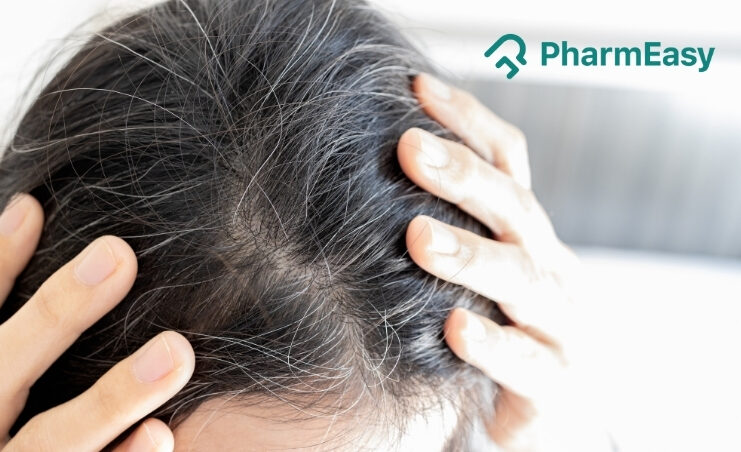What Causes White Hair at an Early Age?
By Dr. Raina N. Nahar +2 more

Get,

to manage your symptom
Get your,


4 Cr+ families
benefitted

OTP sent to 9988776655



You’ve successfully subscribed to receive
doctor-approved tips on
Whatsapp

Get ready to feel your best.

Hi There,
Download the PharmEasy App now!!


Register to Avail the Offer
Send OTPBy continuing, you agree with our Privacy Policy and Terms and Conditions

Hi There,
Sign up on PharmEasy now!!
Trusted by 4 crore+ families

OTP sent to 9988776655



You have unlocked 25% off on medicines




Code: NU25
By Dr. Raina N. Nahar +2 more
Table of Contents
White hair is a normal part of the ageing process, primarily caused by a gradual loss of melanin, the pigment responsible for hair colour. However, some individuals may experience white hair at an earlier age due to factors beyond ageing, including genetics, stress, and certain health conditions. In this article, we will examine the possible reasons for premature greying and explore measures that may help slow or partially reverse this process. Understanding the underlying causes empowers you to manage early white hair more effectively. Finally, we will address some frequently asked questions on the subject1.
Below, we will explore the factors that can contribute to the early onset of white hair.

A family history of early white hair, such as that of your parents or grandparents, may indicate a genetic predisposition. The way these genes influence your body determines when the pigment-producing cells in your hair begin to decline, leading to the appearance of white hair1.
Stress is a common aspect of modern life and may have an impact on hair health. It is believed that stress can affect the pigment-producing cells in hair follicles, potentially contributing to premature greying2.
Autoimmune conditions arise when the immune system mistakenly attacks healthy cells. In coditions such as alopecia and vitiligo, the immune response can affect the pigment-producing cells in hair follicles. Managing these autoimmune conditions may help limit further loss of hair colour and, in some cases, support partial restoration2.
Hormonal changes from thyroid conditions like hyperthyroidism or hypothyroidism could also trigger premature greying of hair. The thyroid gland regulates various bodily functions, including those affecting hair pigmentation. When thyroid function is disrupted, melanin production may decrease, potentially leading to a loss of hair colour2,3.
A deficiency of vitamin B12 may contribute to premature greying of hair. This essential vitamin supports the production of healthy red blood cells, which deliver oxygen to body cells, including those in the hair follicles. Insufficient levels of vitamin B12 can impair the health of hair cells, potentially disrupting melanin production and leading to early whitening4.
Smoking tobacco has been associated with premature greying of hair, with research indicating a link between smoking and greying before the age of 30. In addition to its well-known risks for serious health conditions such as lung cancer and heart disease, long-term tobacco use may contribute to the early onset of white hair1.
If you feel you have started to get white hair before its time, always consult a healthcare professional to rule out the presence of any medical condition that may be causing it.
The science behind white hair involves multiple factors, with melanin production and hair follicle function playing central roles.
Melanin is a pigment made by special cells called melanocytes. It gives colour to our skin, hair, eyes, and also protects our skin from harmful UV rays.
We have two types of melanin, namely, eumelanin and pheomelanin. Eumelanin is responsible dark hair colours while pheomelanin gives a red or yellow tint. Your unique hair colour is determined by the balance of these pigments2.
Melanocytes, the cells responsible for producing pigment, reside within the hair follicles where hair growth occurs. These cells generate melanin, which is incorporated into the growing hair fibre to give it colour. Over time, melanocytes gradually become less active, resulting in a reduction of melanin production and subsequent loss of hair colour.
Hair colour is influenced not only by age and genetics but also by several other factors that are described below.
The chemicals used in hair dyes and products can harm your hair. This can result in loss of colour and white hair. Switching to natural, gentle alternatives may help retain your hair colour2.
Oxidative stress leads to premature white hair. It occurs when there is an imbalance between free radicals and the body’s natural antioxidant defences, potentially leading to damage of hair follicles and a reduction in pigment production. While it cannot guarantee the prevention of greying, adopting a lifestyle that supports overall health, such as consuming antioxidant-rich foods, managing stress levels, and avoiding smoking may help reduce oxidative stress and support the natural condition of the hair2.
Sun rays and pollution can harm your hair and lead to early greying. The key to protecting your hair is to limit sun exposure and include more antioxidants in your diet and hair care routine.
While complete reversal is not generally possible, in certain cases it may be slowed or, to a limited extent, partially reversed, particularly if it is linked to underlying factors such as nutritional deficiencies or stress. Below are some approaches that may help slow the progression of greying or reduce its risk. These should be considered as part of a broader strategy for supporting overall hair health.
Make sure you get enough vitamins and minerals to nourish your hair. Key nutrients to focus on include B vitamins, copper, and antioxidants2.
Natural remedies may help. Using these along with a healthy diet and strong hair care habits may help keep your hair colourful.
While these are a common folk remedy, scientific evidence supporting its effectiveness is limited, and individual results may vary.
Changing your lifestyle in simple ways may boost hair health and colour. To slow down early white hair, focus on stress management, give up smoking, eat a balanced diet, and practice good hair care habits.
A hair care routine may keep your hair healthy and colourful. Using gentle, high-quality hair products may help preserve its natural texture and colour. Additionally, protecting your hair from environmental stressors such as ultraviolet (UV) rays and pollution is important in preventing premature damage1.
Ad* You May Also Explore: Pharmeasy Biotin Tablets
In some cases, medical help may be required for early signs of greying. Based on your specific needs, your healthcare provider may suggest management options.
Hair dyes and colouring can hide white hair and give the desired hair colour. Choose hair dyes that are soft on your hair and contain nurturing ingredients to keep it healthy and vivid.
Also Read: What Causes Fingernails to Split Down the Middle?
For a more long-lasting solution, you might consider professional hair care like scalp micropigmentation or hair transplantation7.
Also Read: Does Masturbation Cause Weight Loss? Debunking Sexual Health Misconceptions
White hair at an early age can be unsettling. However, understanding the underlying causes and exploring available management strategies may help you take a proactive approach to maintaining your hair’s health and appearance. From addressing nutritional deficiencies and making lifestyle adjustments to trying natural remedies or seeking professional advice, various options may support hair vitality. Ultimately, caring for your hair both internally and externally is key to promoting its overall well-being.
Also Read: How To Increase Melanin In Hair Naturally
White hair at an early age can be caused by genes, stress, autoimmune diseases, thyroid disorders, vitamin deficiencies, and damage from UV rays and pollution.
Yes, stress is linked to early white hair since it negatively affects hair follicles’ pigment cells, leading to less melanin.
The average, the onset of greying hair follows a general pattern: by the age of 50, approximately half of the population will have developed some degree of grey or white hair.
In certain cases, if the underlying cause of hair greying is identified and properly addressed—such as a vitamin deficiency or an autoimmune condition, there may be a possibility of some natural pigment returning to the hair. However, if greying is primarily due to genetic factors or the natural ageing process, it is generally considered irreversible.
Yes, white hair is often genetic. It occurs when melanocytes in hair follicles produce less melanin and this reduction is typically inherited through genes.
White hair is generally not reversible through natural means, as it results from a decrease in melanin production. Some treatments may temporarily cover or colour the hair, but they don’t restore the natural pigment.
Yes, white hair is a natural part of aging. It occurs when the production of melanin, the pigment responsible for hair colour, decreases or stops, leading to the loss of colour.
Yes, it is possible to be born with white hair, though it is rare. This condition can be due to genetic factors or albinism, which affects melanin production from birth.
Dandruff itself does not cause white hair. However, persistent dandruff can lead to scalp irritation and inflammation, which might affect hair health, but it does not directly change hair colour to white.
You can pluck white hair, but it’s not recommended as a long-term solution. Plucking can damage the hair follicle and lead to potential issues with hair regrowth.
Disclaimer: The information provided here is for educational/awareness purposes only and is not intended to be a substitute for medical treatment by a healthcare professional and should not be relied upon to diagnose or treat any medical condition. The reader should consult a registered medical practitioner to determine the appropriateness of the information and before consuming any medication. PharmEasy does not provide any guarantee or warranty (express or implied) regarding the accuracy, adequacy, completeness, legality, reliability or usefulness of the information; and disclaims any liability arising thereof.
Comments

Leave your comment...
You may also like
Comments